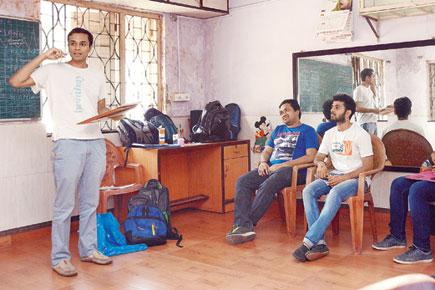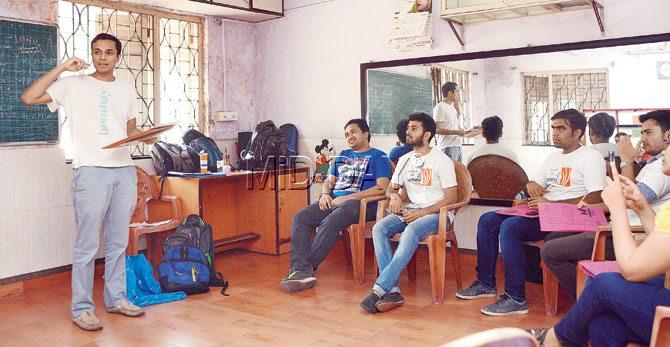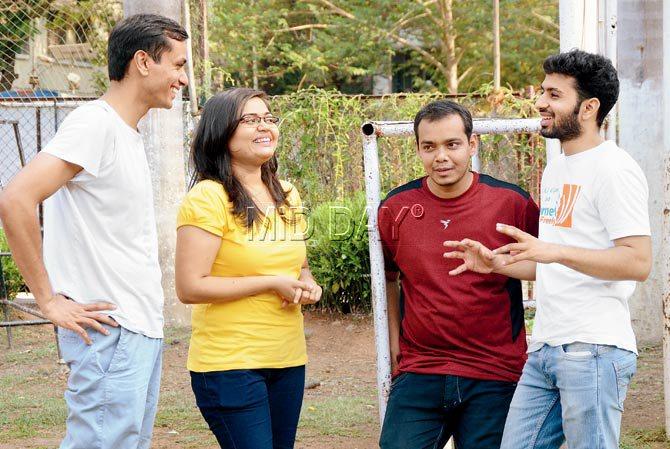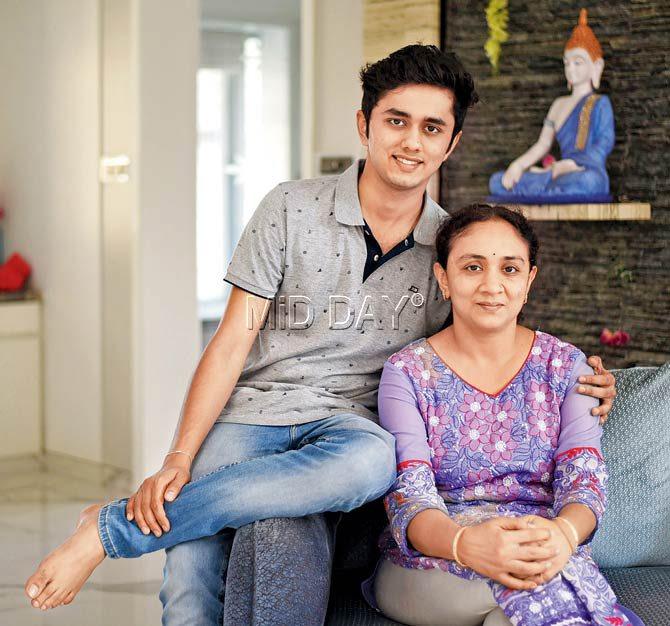A ten-step manual to cope with stammering is a first-ever structured activity devised for Mumbai's stutterers, set to meet at a conference to reinvigorate the self-help movement


TISA, a public charitable trust and self-help movement for people in India who stammer, conducts workshops at YMCA, Ghatkopar, to help develop participants’ communication and leadership skills. Pics/Satej Shinde
 Go to a park and talk to a stranger. After each encounter, note down the colour of the person's eyes along with other facial characteristics - did he have a moustache, was she wearing a teeka or kaajal. Follow this routine for a few weeks, until you are mentally adept at registering key facial features within the first few minutes of the dialogue. Soon, you will develop firm eye contact with anyone you talk to. As you stop looking away, which most stutterers do, you will develop a positive body posture. Your firm gaze (not stare) will be your way of telling the world that you can communicate despite your stammer and you want others to receive it as a distinctive speech diversity, not a handicap or a disorder that you are ashamed of.
Go to a park and talk to a stranger. After each encounter, note down the colour of the person's eyes along with other facial characteristics - did he have a moustache, was she wearing a teeka or kaajal. Follow this routine for a few weeks, until you are mentally adept at registering key facial features within the first few minutes of the dialogue. Soon, you will develop firm eye contact with anyone you talk to. As you stop looking away, which most stutterers do, you will develop a positive body posture. Your firm gaze (not stare) will be your way of telling the world that you can communicate despite your stammer and you want others to receive it as a distinctive speech diversity, not a handicap or a disorder that you are ashamed of.
ADVERTISEMENT
This Eye Movement Training is one of 10 crucial steps laid down in the self-help manual created by Mumbai-based Dhruv Gupta and Dehradun-based Dr Sachin Srivastava, founders of The Indian Stammering Association (TISA), that offers participants an Effective Communicator Certificate at the end of a course.
Gupta, who works in a climate change mitigation firm, has experimented with a variety of speech therapies to deal with his own stammer. Before he settled in Mumbai and crystallized the self-help group that meets at a Ghatkopar venue every week, and sometimes in Borivali, he took on disconnected professional assignments, including reviving a restaurant in Guangzhou and studying post-harvest food security at an Oregon-based non-profit. All of these required him to hone communications notwithstanding the stammer.

(Left to right) Dhruv Gupta, Bhavana Patil, Saurabh Pandey and Ashok Agicha of the The Indian Stammering Association (TISA).
Time, six years, spent in America to learn more about the programmes run by the Stuttering Association for the Young and the American Institute for Stuttering helped him gather ammo to put to use at TISA, where he has been a volunteer since 2013, and he later founded the Speak: Stammering Foundation, a registered non-profit that seeks to gather resources for those who struggle with a condition when the flow of speech is interrupted by involuntary repetition or prolongation of sounds.
Today, Gupta and his core team of 20 volunteer-mentors have a clear goal – use the stutterer's manual to build a close-knit community of People Who Stammer (PWS) in the city. Around one per cent of Mumbai stutters (accounting for more than 20 million in the city; the national average is also 1 per cent), yet it has been difficult to shape a network of people who can allot time to group therapy. It is not that cities around the world have better participation rates. Having collaborated with groups in London and New York, both with a sizeable stammering population, he says they have a miniscule percentage of members who participate in a collective effort.
Self-help groups in India too are perceived as optional need-based programmes, which stutterers subscribe to only when they want to "fix the stammer" before a job interview, after a situation of ridicule, or before they look to get married. Studies done by TISA show that most are comfortable with hiding or camouflaging their stammer, and they'd rather seek treatment that doesn't tax their daily routine. This often encourages quackery.

Bhavna Panchamia, whose 23-year-old son Rishabh is a PWS, has written to the Ministry of Health and the Ministry of Women and Child Welfare — their petition is on change.org — seeking awareness, assistance and social dignity to those who stammer. Pic/Nimesh Dave
The Mumbai manual hopes to challenge this 'let's-cure-it in haste' practice. It demands a good two-and-a-half months of a stutterer's time, if he chooses to take the course in a classroom set-up, with regular home exercises. It can extend to longer if the regimen isn't followed.
As of now, the 10-step manual has been set into motion for 160 stutterers in Mumbai, all connected on a WhatsApp group and through the self-help class. Meanwhile, the city's 'unorganised' stutterers have been asked to "let the stammer out" at Mumbai Stammers: One Day Conference, scheduled at Somaiya Vidyavihar on May 27, much on the lines of the May 28 NYC Stutters event. Several workshops have been designed to be held as part of the Mumbai conference, free of cost, so that the city appreciates the history of the self-help movement in India, and in turn becomes a model for city-centric stutterers' conventions, for smaller metros like Dhanbad, Patna, Panaji, Meerut and Jaipur where TISA hopes to penetrate.
While the loosely held community of PWS uses fun components like role play, video and audio recordings, Google Hangout, daily e-meets and Skype chats across continents to battle the speech challenge, the manual hopes to offer each a mentor-evaluated context where each exercise has a collective and a meditative dimension. For instance, the Draw Your Stammer Iceberg activity asks the participant to look inward and jot down all the visible (face grimaces, eyes closing) and invisible manifestations of stammering (avoiding speech, changing an order in a restaurant to duck pronouncing a convoluted phrase). This iceberg helps to map the physiological and psychological problem (though it is not to be called a problem in TISA circles) on a piece of paper. It also leads to an acceptance of the stammer, and cuts out the associated shame. The manual goads the participant to share (starting with inanimate objects and then moving to humans) his or her stammer matter of factly, not as a sentimental sob story. In fact, there are special jokes devised around stammering. Stutterers are encouraged to stick up a TISA poster or have a coffee mug with stammering-related inscriptions (Haklao, magar pyar se) and proudly declare that they "belong to a VIP club of stutterers like Darwin, Newton, Churchill, Bruce Willis and Hrithik Roshan."
The vocalization exercises for PWS are essentially a replay and review of words, accents, pitch, pronunciation and breath control. The technique of Bouncing (repeat the first sound of a word before saying the full word and then the sentence in the normal speed), and Gentle Onset (prolong the vowels, soften the hard consonants) are broken down in exhaustive detail with entertaining examples in the manual. It lists common glitches and attitudinal blocks of stutterers who have left their therapy midway out of boredom or frustration. Interestingly, older people who once showed readiness to 'play with their throat' in the self-help group in Mumbai have not been able to keep up the regularity. Sion-based exporter Viren Gandhi (46) was the first to initiate a Mumbai–centric Yahoo group to connect with others like him. But soon, work and family commitments took precedence. "Life continues in this city of distances. I must admit that I still struggle with my speech block. I wish younger people make the effort to form clubs, online and offline. We need to consciously create an extended family. Like any other family, this one also cannot survive on its own."
Harish Usgaonkar, 36, the Goa coordinator of TISA, agrees. "In Mumbai, life is too fast-paced to allow a Sunday evening meeting for PWS. Yet the Mumbai group is among the more active TISA constituents. In Panaji, we have struggled to retain our members. Hopefully the structured manual, which we have implemented in bits and parts, will add the zing of a classroom to our work."
Interestingly, TISA organises one Skype meeting and one daily Google Hangout session for all members on a national level, although few PWS know of it, and fewer still avail of it. There is a reason why onlookers can join the session - those who don't stammer should know the source of a challenge for many around them. The stammer needs a hearing, a patient one.
Sumedha Raikar-Mhatre is a culture columnist in search of the sub-text. You can reach her at sumedha.raikar@gmail.com
 Subscribe today by clicking the link and stay updated with the latest news!" Click here!
Subscribe today by clicking the link and stay updated with the latest news!" Click here!







